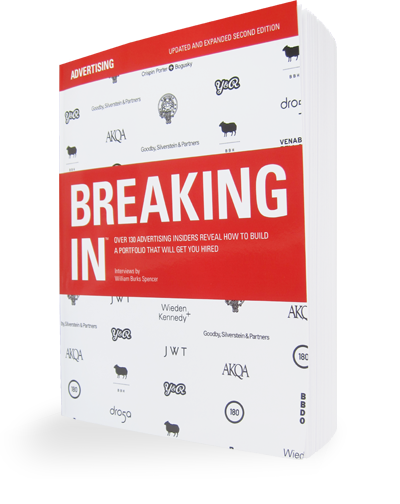If you missed the last post, check out some Tony Granger TV spots here.
TG: …The people who succeed are naturally inquisitive. They hang onto their childlike enthusiasm about the business. They have an instinctive feel for innovation and an innate comfort with technology.
I think it’s also important, if you’re a student, to thoroughly dissect the
media landscape today and know what’s happening—who’s doing what,
which agencies are the best, what kind of work is getting the accolades,
what people are buzzing about on blogs. Schools can teach you a lot, but
you’ve got to have a natural passion for the work and lots of motivation.
WS: Some people say the idea is the most important thing. That’s the only
thing they care about. Where does craft fit in? Are they both important? Is it
enough to have the big ideas, or do you also have to have the craft as well?
TG: Both are important, absolutely. But you have to be careful about
what you think craft means. People often think craft means “beauty.”
But it’s really about having the talent to create something completely
appropriate to the idea. Is it right to use 16mm film, or more appropriate
to shoot with a hand-held? Does the work call for elaborate typography,
or are you going to spray words on a wall? So you have to have both lots
of knowledge and great instincts. Craft is the window to an idea, not the
wallpaper around it.
WS: It seems like it is getting harder and harder to get into the business.
What does it take to stand out at that level?
TG: You need to be enthusiastic. Passionate. Your work needs to be
brilliant. But maybe the most important thing, really, is to have a wide-
eyed enthusiasm about our business. That’s what’s going to make the
difference.
WS: Is it important to have a mentor, and if so, how can a student hook
up with someone who’s already in the business?
TG: The easy answer is that you need to find people you want to learn
from. It’s important for people to have many mentors throughout their
careers.But then, there’s a second piece to it. Some of the best mentors you’ll
have are people you’ll never meet. They may not even be alive anymore.
I’ve always drawn my best inspiration from popular culture. My mentors
have always been artists and musicians and filmmakers and writers—
some of whom were long gone before I was born. The thing is, great
creatives know great advertising, but they don’t stop there. They reach
beyond the industry and immerse themselves in all kinds of ideas and
ways of achieving your craft. If you’re only looking at advertising, the
work gets too insular and self-referential. I’m telling you, that’s a deadly
formula. Learn what you can from your cultural heroes.
WS: What do you think of putting things in the portfolio that aren’t ads?
TG: A must. Our business is about content today, and it has many forms
and faces. It’s digital to the core. So, your portfolio has to reflect the
industry. That might mean you’ll want to put in ideas for movies, or new
products, or a concert tour, or video game. But not gratuitously. You
want to show that you have a wide and varied creative palette, but the
important thing is to show ideas that are so strong, they seem inevitable
for the brand.
WS: I just want to ask you a little more about that because it’s interesting.
What do you see as the future of advertising? Is it content and entertainment,
or a wide range of things?
TG: Absolutely. Technology has empowered people to engage with the
content they want to, on their own time, and in formats of their choosing.
So to get noticed and to engage, you need to have ideas that can move
across channels. Our job is to create work that is irresistible and draws
people to it…

Comments are closed.